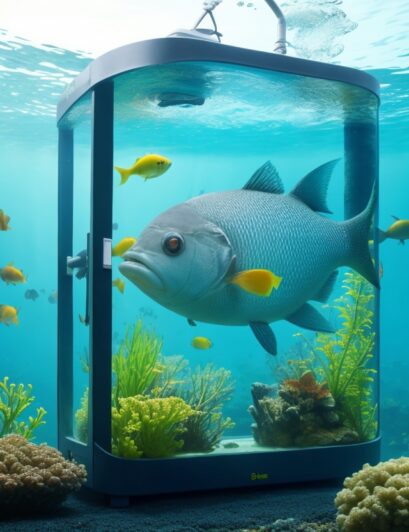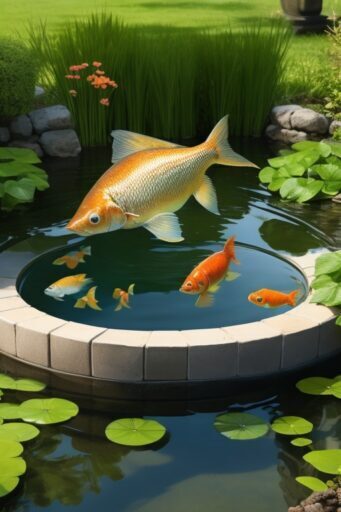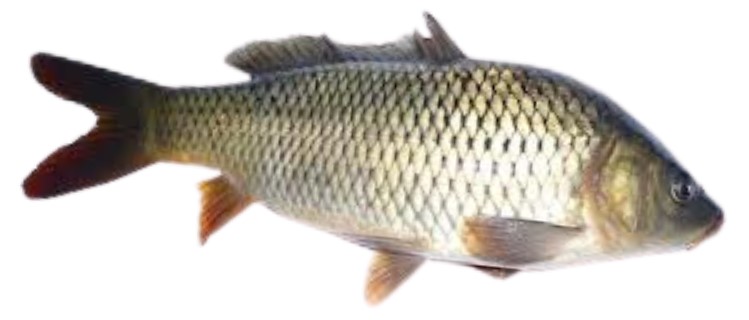Freshwater Catfishes: Catfishes belong to order Siluriformes. It is one of the second largest orders of teleosts containing more than 4100 species which represent 12% of all teleosts fish and 6.3% of all vertebrate animals (Eschmeyer and Fong, 2014; Wilson and Reeder, 2005). Catfish are highly diverse and distributed worldwide. They are commonly found in inland or coastal waters of all continents.
Catfish are familiar with the barbels (Mustache) around their mouths and have scale less skins, fleshy, rayless posterior fins, and sharp defensive spines in the shoulder and dorsal fins. They are able to use the swim bladder to produce sounds, and have a complex set of bones forming a sensitive hearing apparatus. Some species, such as the stone and tadpole catfishes and the madtom, can inflict stings by means of poison glands in the pectoral spines. The freshwater catfish are commercially important. They are commonly called predatory fishes.
Identification Characters and Importance of Freshwater Catfishes
1. Clarias batrachus (Linnaeus) 1758.
 |
| Clarias batrachus |
B.9; D.62-76; P.9-12; (1/8-11); V.6; A.48 -58; C. 15-17; Barbels.6
Local names : Mangur, Magur,Mangri.
Environment : Dermisal, potomodromous, freshwater, brackish, depth range 1 m.
Climate : Tropical, 18 – 260C.
Dangerous : Potential
Characters :
- Length of head is 5.6 and the height is from 6.5 to 7.5 in the total length.
- Head is depressed and the body is elongated.
- Gape of the mouth is moderate, anterior and transverse.
- Occipital process is angular and narrow.
- Barbels are eight; maxillary extends beyond the base of the pectoral fin.
- Dorsal fin is very long; it originates a little behind the occipital process and ends a bit anterior to the base of the caudal fin.
- Caudal fin is free.
- Body is brownish black.
- All the fin or covered with thick skin.
Remarks : It attains a maximum length of 47.0 cm. Due to the presence of accessory respiratory organs, it is useful for culture in swamps. It is supposed to be a very nourishing fish.
Importance : Fisheries: commercial; aquaculture : commercial aquarium: commercial.
2. Heteropneustes fossilis (Bloch) 1785
 |
| Heteropneustes fossilis |
B.7; D.6-7; P.8 (1| 7); V.6; A.60-79; C.19; Barbels 8.
Local names : Singi, Bitchuka, machi.
Environment : Demersal, freshwater, brackish.
Climate : Tropical.
Dangerous : Harmless.
Characters :
- Length of head ranges from 5.5 to 7 and the height of body from 5 to 8 in the total length.
- Body is sub cylindrical upto pelvic, compressed behind.
- Head depressed occipital process not extending to base of dorsal fin.
- Mouth small terminal.
- Barbels are eight, maxillaries reaching middle of the pectoral or even to the pelvic fin.
- Dorsal fin short spineless.
- Ventral fin originates below the dorsal fin origin.
- Pectoral spine is serrated.
- Anal fin is long based, with 60-79 fin rays, not united with caudal.
- The body is dark leaden brown; the young are reddish.
Remark : It attained 30cm in length or more. The pectoral spine of this fish is capable of inflicting wounds, which is very painful, and hence people are afraid of catching it without breaking the pectoral spine. It is considered to be very nourishing and tasty fish.
Importance : Fisheries: highly commercial; aquaculture: commercial; aquarium: commercial
3. Wallago attu (Bloch & Schneidar) 1801
 |
| Wallago attu |
B.19-21; D.5; P.14-16 (1/13-15); V.8-10; A.86-93 (4/82-89); C.17; Barbels 4.
Local names : Boalee, Parhin, Shivada, pattan, pari, purrum.
Environment : demersal, freshwater, brackish
Climate : Tropical 22-25oC; 38o N- 10o S
Dangerous : traumatogenic
Characters :
- Length of head ranges from 5 to 5.5 and the height of body from 6.3 to 6.5 in the total length.
- Body is compressed and the head is depressed, and the mouth is oblique.
- Cleft of the mouth extends to nearly an eye diameter behind the orbit.
- Lower jaw is more prominent.
- Barbels are four in number; maxillary extends beyond anal origin.
- Dorsal fin is short, spineless and as long as pectoral.
- Pectoral spine is moderately strong and finely serrated.
- Caudal fin is forked and not united with anal.
- Body is uniform silvery gray becoming lighter below.
Remarks : It attains about 240 cm in length and is often referred to as a freshwater shark on account of its large mouth, this species is good for eating and salts.
Importance : Fisheries: commercial; game fish: yes.
4. Mystus cavasius (Ham) 1822.
 |
| Mystus cavasius |
B.6; D.8 (1/7)|0; P.9 -10(1/8 -9); V.6; A.11-13 (3-4|7-9); C.16; Barbels 8.
Local names : Tengara
Environment : Demersal, freshwater, brackish.
Climate : Tropical, 50N- 380N.
Dangerous : Venomous.
Characters :
- Length of head ranges from 5.5 to 6.2 and the height of body from 5.2 to 6.5 in the total length.
- Body is elongated and the naked mouth is terminal and transverse.
- Snout is somewhat obtuse, the upper jaw is longer.
- Cleft of the mouth extends to below the orbit.
- Head conical, median longitudinal groove extending to base of occipital process.
- Barbels are eight, the maxillary barbels extend beyond the base of the caudal fin.
- Dorsal spine weak, feebly serrated.
- Adipose fin large, inserted close behind the dorsal fin.
- Pelvic fin originated just behind the base of the dorsal fin.
- Caudal fin is forked, the upper lobe being the longer and more pointed.
- Body is leaden above and yellowish on the abdomen and checks.
- There is a black spot covering the basal bone of the dorsal fin, pectoral, pelvic and anal fins are adult white.
Remarks : It attains about 40 cm in length. It is predatory in habit and attacks small carps, other small teleosts and prawns.
Importance : Fisheries commercial.
5. Mystus seenghala (Sykes) 1839
 |
| Mystus seenghala |
B.12; D.8 (1/7)|0; P.10 (1/9); V.6; A.11-12 (3/8-9); C.19-21; Barbels 8.
Local names : Ari, Pongal, Singala,Singata.
Environment : Demersal, freshwater, brackish.
Climate : Tropical, 390N- 80N.
Dangerous : Harmless.
Characters :
- Length of head ranges from 4.1 to 4.5 and the height of body from 7.5 to 8.0 in the total length.
- Clef mouth is shallow.
- Body is elongated and naked, the mouth is sub terminal and transverse.
- Snout board and spatulate.
- Upper jaw is longer than the lower.
- Barbels are 8, maxillary pair reaching to middle or just beyond rayed dorsal but never reaches the caudal fin.
- Dorsal spine weakly serrated on posterior edge.
- Adipose fin base short, as long as ranged dorsal fin base.
- Pectoral spine is stronger than the dorsal and serrated.
- Caudal fin is deeply forked and its upper lobe longer.
- Body is brownish gray superiorly and silvery on sides and abdomen.
- A black spot is found on the hind end of the base of the adipose fin.
Remarks : It attains at least 98 cm in length, it is predatory in habit and attacks small carps, other small teleosts and prawns.
Importance : Fisheries, commercial, game fish- yes.
6. Mystus aor (Ham) 1822
 |
| Mystus aor |
B.12; D.8 (1/7) 10; P.10-11 (1/9-10); V.6; A.12-13 (3-4/9) C.17; Barbels 8.
Popular names : Mystus
Local names : Katarna
Environment : Dermisal, freshwater.
Climate : Tropical.
Dangerous : Harmless.
Characters :
- Length of head ranges from 4.5 to 5 and the height of body from 6 to 8.8 in the total length.
- Body is elongated and the naked mouth is terminal and transverse.
- Snout is broad and spatulate.
- Mouth is a sub terminal.
- The upper jaw is longer.
- Barbels are eight, maxillary barbells reach the base of the caudal fin or even beyond it.
- The Dorsal spine has its posterior edge finely serrated.
- Adipose fin long, having its base twice as that of the rayed dorsal fin.
- A dark spot on the tip of the adipose fin.
- Body is bluish lead above becoming white on the abdomen, fins are yellowish, tinted gray.
Remarks : It is said to attain upto 180 cm in length this fish is eaten locally.
Importance : Fisheries – commercial , Game fish :yes.
Read more: https://www.infoplease.com/encyclopedia/ecology/animals/vertebrates/catfish






